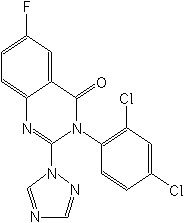-
Common NameFluquinconazole
-
中文通用名氟喹唑
-
IUPAC3-(2,4-dichlorophenyl)-6-fluoro-2-(1H-1,2,4-triazol-1-yl)quinazolin-4(3H)-one
-
CAS3-(2,4-dichlorophenyl)-6-fluoro-2-(1H-1,2,4-triazol-1-yl)-4(3H)-quinazolinone
-
CAS No.136426-54-5
-
Molecular FormulaC16H8Cl2FN5O
-
Molecular Structure
-
Category
-
ActivityFungicide
Fluquinconazole is absorbed mainly through foliage. The product moves systemically through the xylem and through leaf tissue: this property explains the efficacy of fluquinconazole against endophytic organisms such as Septoria spp and rusts. It can be used as a protectant or a curative treatment. The product is rainfast within ten minutes and has residual activity lasting more than 40 days. Fluquinconazole has shown no phytotoxicity to foliage and fruit in orchards and is safe to beneficial insects. The selectivity in wheat when applied as seed treatment is good.
In field trials, fluquinconazole gave better or equal control of a range of diseases than established products. Phytoma (December 1997) reported that AgrEvo conducted field trials with fluquinconazole-treated wheat seed that gave very encouraging results. Later reports (Phytoma, November, 1999, BCPC, 2000) provide evidence that fluquinconazole seed treatments can provide protection against take-all (Gaeumannomyces graminis var. tritici) in wheat. This action is attributed to a number of effects including increase in root diameter and vigour, a change in root morphology which increase resistance to attack by the pathogen, direct effects on hyphal development and stimulation of growth of antagonistic organisms such as Pseudomonas fluorescens.
The protective effect is less pronounced in barley. There is evidence that fluquinconazole can exert a significant residual effect in the control of take-all so that disease incidence is reduced in following crops.
For seed treatment applications in wheat, control of diseases caused by Fusarium spp is achieved by addition of a partner such as prochloraz
Aventis developed a new formulation of Flamenco, now launched in France, containing the adjuvant Maximiser. The addition of this adjuvant is reported to give faster action without adverse effect on the efficacy, flexibility or persistence. -
CropUseCropUses:
cereals, fruits, oilseed rape, vegetables, vines
Cereals
125-250 g ai/ha
Fruit
5-7.5 g ai/hl
Vegetables
125-375 g ai/ha
-
PremixSuspension concentrate, wettable powder, water dispersable granule, suspoemulsion.
Premix Parters: aminopyralid; bromoxynil ioxynil; clopyralid; 2,4-D; 2,4-D dicamba; 2,4-D MCPA; MCPA; picloram; triclopyr;
-
Physical PropertiesMolecular weight:376.2; Physical form:Cream/pale brown, crystalline solid. Density:1.58 (20 °C); Melting point:191.9-193 °C ( tech., 184-192 °C); Vapour pressure:6.4 ×10-6 mPa (20 °C); Henry constant:2.09 × 10-6 Pa m3 mol-1; Partition coefficient(n-octanol and water):logP = 3.24 ( pH 5.6); Solubility:In water 1 mg/l ( pH 6.6, 20 °C). In acetone 50, xylene 10, ethanol 3, dimethyl sulfoxide 200 (all in g/l).; Stability:In water, DT50 (25 °C) 21.8 d ( pH 7). Stable to light.
-
ToxicologyOral:Acute oral LD50 for male and female rats 112, male mice 325, female mice 180 mg/ kg. Percutaneous:Acute percutaneous LD50 for male rats 2679, female rats 625 mg/kg. Non-irritating to skin and eyes (rabbits), and not a skin sensitiser (guinea pigs). Inhalation: LC50 (4 h) for rats 0.754 mg/l. ADI:0.035 mg/ kg.
-
Environmental Profile
Ecotoxicology:
Algae:For Selenastrum capricornutum, ErC50 46, EbC50 14 μg/l.Birds:Acute oral LD50 for bobwhite quail and mallard ducks >2000 mg/ kg.Daphnia: LC50 (48 h) >5.0 mg/l.Fish: LC50 (96 h) for bluegill sunfish 1.34, rainbow trout 1.90 mg/l.Worms: LC50 (14 d) for Eisenia foetida >1000 mg/ kg soil.Other beneficial spp.:Harmless to a range of representative species in the field.
Environmental fate:
Animals:Metabolised to 1,2,4-triazole.Soil:Slowly degraded in soil via hydrolysis to the dione. Degradation rates depend on temperature, soil moisture, soil pH and organic matter content. Typical field DT50 50-300 d. -
Transport InformationHazard Class:O (Obsolete as pesticide, not classified)
Porduct NewsMore
Bayer develops alternative to glyphosate herbicide
Colombia’s Constitutional Court bans chlorpyrifos
ADAMA Canada moves forward with lambda-cyhalothrin sales for 2023
Mexico: Import of glyphosate drops from 16,500 tons to 8,200 tons
Glyphosate prices drop 30% in Argentina
One year extension of EU glyphosate approval failed to pass in the latest meeting
Palmer amaranth in two southern U.S. states now resistant to S-metolachlor

 0
0 Subscribe
Subscribe
